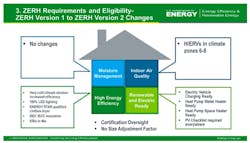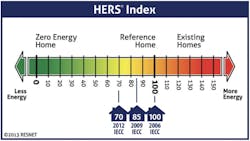How the Zero Energy Ready Home Update Emphasizes Resilience and Decarbonization
In June of 2023, Texas sweltered under a heat dome that strained the grid. By July, the heat wave had expanded to smother the entire southern half of the U.S. At one point, one-third of all Americans were under some sort of heat advisory. Just a few months before, in February, residents in the Northeast shivered during a life-threatening cold snap.
Extreme weather events—prolonged heat waves, record rainfalls, and brutal snowstorms—are testing our infrastructure and underscoring the critical need to both reduce greenhouse gas emissions and shore up our buildings. Homes built to the requirements of the Department of Energy’s Zero Energy Ready Home (ZERH) program are ready for this new reality. ZERH Single Family Version 2, released in December of 2022, will boost the efficiency and performance of this building type even more. While Version 2 does feature some equipment and system efficiency upgrades, the major changes focus on improved resiliency and decarbonization.
“The updated ZERH program is part of an aligned suite of actions that are helping us make step-wise progress toward our ambitious energy targets and drive towards the administration’s goal of a net zero emissions economy,” says Jaime Van Mourik, ZERH Program Director.
Homes certified under the updated standard will feature boosted thermal envelopes; they will also be wired for solar, EV charging, and electric water and space heating. | All images: courtesy U.S. Department of Energy
Going Low: Reduced Energy Rating Index Targets Means Higher Efficiencies
Version 2 increases the already stringent requirements for energy efficiency by changing Energy Rating Index (ERI) Targets across the board. These targets, which take into account everything from insulation levels to HVAC equipment to the air tightness of the home, are generated by energy rating software and set customized performance goals for each project.
The ERI scores range from 0 to 100; in this case, a lower score is better—that is, more efficient. “While scores will vary somewhat depending on the specific design and location, targets to meet V2 will generally fall in the mid-40s,” says Sam Bowles, marketing director for the ZERH program. “By contrast, ERI targets for V1 ranged in the 50s.” In a typical home built to energy codes, the ERIs range in the 70s.
Each percentage point represents a 1 percent change from the reference design. For example, a home with a score of 45 is 10 percent more efficient than a home with a score of 55, assuming they are using the same reference design.
Project teams can choose how to meet (or exceed) their ERI target. For example, Builder A might opt for a very high efficiency heating and cooling system but a slightly less efficient water heater, while Builder B might beef up the building envelope with a staggered stud wall or extra insulation.
“If either design achieves the required ERI Target for ZERH, those designs would satisfy the program’s energy efficiency requirements,” explains Bowles, “but V2 has other mandatory provisions that builders must meet to earn the certification, which may limit the extent of tradeoffs that can be used in the ERI modeling. For example, projects cannot go below the minimum envelope standards, even if they could hypothetically make up the loss elsewhere in the ERI modeling.”
While Version 2 does feature some equipment and system efficiency upgrades, the major changes focus on improved resiliency and decarbonization.
Some of these “must-haves”—which are required for every single ZERH-certified home—recognize that a home’s initial construction is the best, if not only, time during the home’s lifecycle to incorporate measures that contribute most to a home’s overall performance.
A Bolstered Energy Envelope
The ZERH program has always stressed the one-time opportunity to create a robust thermal building envelope when building a new home. Insulation levels in the original standard followed the 2015 International Energy Conservation Code (IECC); the updated version follows the 2021 IECC.
Insulation levels for ceilings have increased in every climate zone except for Climate Zone 1, and levels for wood-framed walls have expanded in Climate Zones 4 and 5. Notably, continuous insulation is now required in these climate zones. (Previously, it was only required in very cold climates.) Slab edge insulation is also now required in Climate Zone 3. And in Climate Zones 4 and 5, the minimum depth of slab edge insulation has doubled from 2 feet to 4 feet.
These changes boost not only a home’s energy efficiency but its resilience. A home with a bolstered energy envelope is able to withstand extreme temperatures better, which are occurring more frequently because of climate change. Resilience in these new circumstances is not just a matter of comfort. They are potentially life-saving. Prolonged heat waves have claimed dozens of lives in recent years—both in places like Portland, Ore, where residents are unaccustomed to 100-degree temperatures, and in towns and cities in the Southwest, where temperatures soared above 110 for weeks at a time. Tragically, some people succumbed to the deadly heat while in their own homes.
The performance requirements for windows have also been updated in V2 and are based on ENERGY STAR V6.0 specifications with the exception of Very Cold Climates (CZ 6-8): here, the requirement is even more vigorous at U 0.25, as controlling heat loss in cold climates, where heating energy is proportionally higher, is critical. Builders are encouraged to go even further, says Bowles. “Note that these values are minimum performance level backstops,” he explains. “Builders may choose to use even more efficient windows, and in turn, use this added efficiency as part of an envelope UA approach involving tradeoffs elsewhere in the envelope.”
Going Electric With Electric Ready Requirements in ZERH
Electrification and decarbonization are inextricably linked: Replacing gas and propane water heaters and space heating systems with electric versions can significantly reduce carbon emissions, especially when the grid is powered by renewable energy. Electric homes also provide a healthier indoor environment by eliminating natural gas combustion inside the home. For these reasons, ZERH V2 includes new requirements for “electric readiness.”
“Electric Ready requirements in the ZERH program support DOE’s goals for greenhouse gas reductions and moving towards clean electricity,” says Bowles.
While ZERH V2 does not require all-electric designs, the program is anticipating an all-electric future, where the most efficient technologies are prioritized. As a case in point, V2 requires an electric-ready circuit when a gas-fired water heater is installed. More specifically, the builder must include an individual branch circuit intended to accommodate a future heat pump water heater. Such water heaters work by extracting heat out of the air and using it to heat water in a tank; they are two to three times as efficient as conventional electric resistance heaters.
In addition, the updated ZERH program requires homes to be wired with dedicated circuits for electric vehicle chargers and for heat pump space heaters, regardless of what type of heating system the home uses.
The program’s solar-readiness requirements have also ramped up. ZERH’s “PV-ready” checklist includes, among other things, a dedicated circuit breaker for a solar array and conduit for wiring. But in V1, only sites with an average daily solar radiation above 5 kWh/m2/day—essentially, the Southwest, Florida, and parts of Alabama, Georgia and South Carolina—were required to complete it. In V2, the threshold has been eliminated, which means any home built in the continental U.S. must comply.
“In V2 we considered the widespread growth of residential PV and the 64 percent reduction in cost in residential PV systems since 2010,” says Bowles. “This makes solar energy viable in a wide variety of locations and therefore this exception was sunset.” Builders can still seek exceptions for site-specific conditions such as significant shading.
It is a sobering irony that extreme climate events like heat waves push energy use to new extremes. During the 2023 heat wave, for example, Texas saw record-breaking energy use that strained the state’s power grid. Low-energy homes not only protect occupants from extreme conditions, they reduce the greenhouse gas emissions that are making the problem worse. As the climate continues to change, the ZERH program is preparing homes for a future that may have already arrived.
Jaime Van Mourik, Associate AIA, LEED AP, is an ORISE Science, Technology, and Policy Fellow in the Building Technologies Office of the Department of Energy supporting the Residential Buildings Integration program working toward a zero carbon emissions future for all homes.



